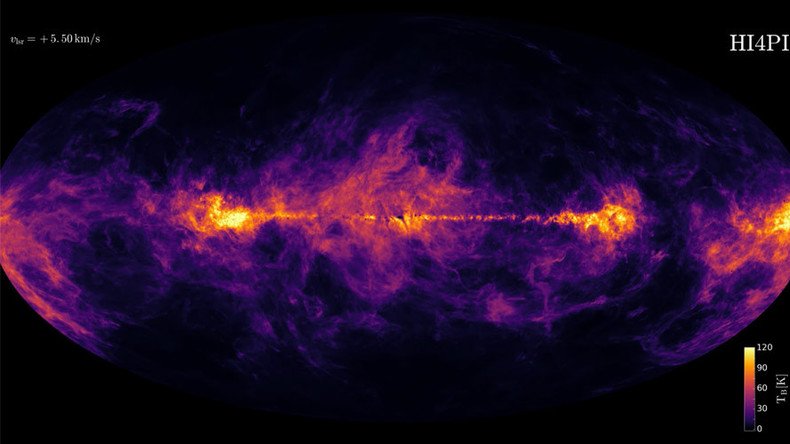Stunning map of Milky Way created using giant telescopes (VIDEOS)

A team of scientists have created a map of the Milky Way by using the world’s largest steerable telescopes from Germany and Australia.
Known as HI4PI, the detailed map was produced using the 100-meter Max-Planck radio telescope and the 64-meter CSIRO radio telescope from both countries by the International Centre for Radio Astronomy Research (ICRAR).
“We’ve basically put together a very complex map of hydrogen gases associated with our own Milky Way,” said Naomi McClure-Griffiths, a professor from the Australian National University, reported AFP.
Researchers examined neutral atomic hydrogen – the primary component of stars and galaxies – and the project required more than a million individual observations and around 10 billion individual data points.
Dr Juergen Kerp, astronomer from the University of Bonn in Germany, said the neutral atomic hydrogen element is quite easy to detect by using modern radio telescopes, however, mapping the entire sky was a huge achievement.
“Radio ‘noise’ caused by mobile phones and broadcast stations pollute the faint emissions coming from stars and galaxies in the universe,” Kerp said. “So sophisticated computer algorithms have to be developed to clean each individual data point of this unwanted human interference.”
“Next to the thousands of observing hours an even larger amount of time has been spent creating the final scientific data product released today,” he added.
READ MORE: The loneliest star revealed in Milky Way bulge
Animation footage released by ICRAR shows radio emission from neutral hydrogen atoms located in the Milky Way and neighboring dwarf galaxies, the Large and Small Magellanic Clouds.
The colors from the sequence reflect the approaching purple and blue, along with receding orange and green hydrogen gas motion, while the brightness traces the amount.
HI4PI Animation from ICRAR on Vimeo.
Another animation shows the HI 21-cm line emission of neutral atomic hydrogen in the Milky Way along with neighboring galaxies such as the Andromeda galaxy and the Magellanic Clouds, which can both be seen in the lower half of the panel.
The bright colors can be seen expanding as the video goes on.
Professor Lister Staveley-Smith from the ICRAR said such intricate details between the stars of the Milky Way have been revealed for the first time.
“Tiny clouds become visible that appear to have fuelled star formation in the Milky Way for billions of years,” Staveley-Smith said. “These objects are too dim and too small to be detected even in the other galaxies closest to us.”
READ MORE: Surrounded by stars: Mesmerizing Milky Way mirrored in Bolivia's salt flats (PHOTOS)












